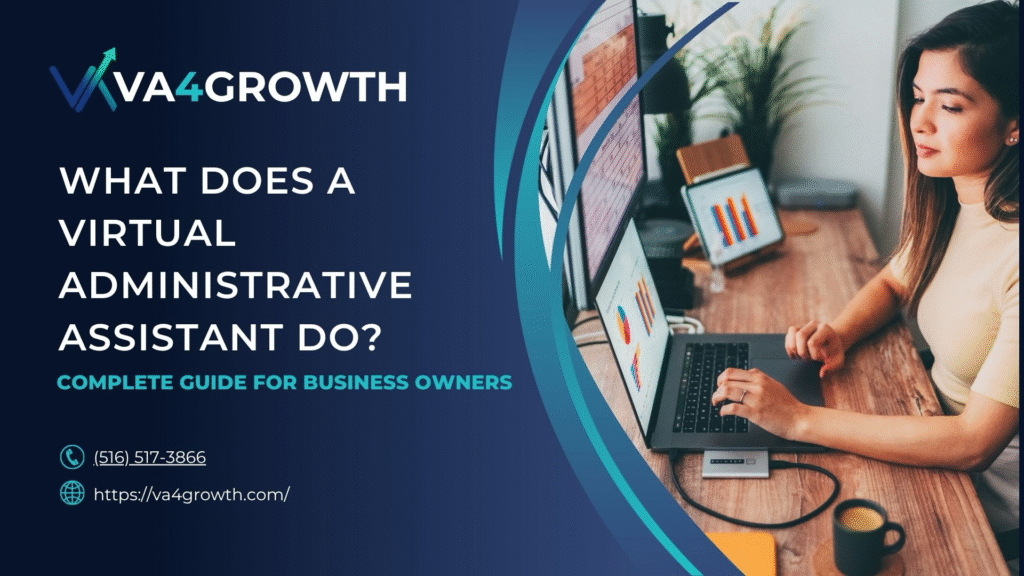A virtual administrative assistant is a remote professional who manages essential business tasks like scheduling appointments, handling emails, organizing documents, and coordinating meetings without being physically present in your office.
These skilled professionals work from their own locations while helping you streamline operations, reduce costs, and focus on growing your business instead of getting buried in daily administrative work.
If you’re a business owner juggling too many tasks and wondering how to get everything done without hiring full-time staff, understanding what a virtual administrative assistant does can change how you run your company.
Ready to discover how a virtual administrative assistant can free up your time and boost productivity? Keep reading to learn exactly what tasks they handle and how to decide if hiring one is right for your business.
What Is a Virtual Administrative Assistant?

A virtual administrative assistant (VA) is a remote worker who provides administrative support to businesses, entrepreneurs, and busy professionals from a distance. Unlike traditional office assistants who work on-site, virtual assistants operate from their own workspace using digital tools and communication platforms to complete tasks.
Basic Definition and Role
Think of a virtual administrative assistant as your right hand, but working remotely. They handle the routine administrative tasks that eat up your valuable time, tasks that are necessary but don’t directly generate revenue for your business.
These professionals are self-employed contractors or work through agencies that connect them with clients. They use email, project management software, video calls, and cloud-based tools to stay connected and productive.
The “virtual” part means they work from anywhere with internet access. The “administrative” part means they focus on organizational, clerical, and support tasks rather than specialized work like graphic design or programming.
How Virtual Assistants Differ From Traditional Assistants
Virtual administrative assistants bring flexibility that traditional office assistants cannot match. You hire them for specific hours or projects rather than committing to full-time employment with benefits, office space, and equipment costs.
Traditional assistants work set hours in your physical office. Virtual assistants work according to agreed schedules that might span different time zones, giving you extended coverage for your business operations.
Cost savings are significant. You pay only for productive hours worked, not for breaks, sick days, or downtime. You also avoid expenses like desk space, computers, insurance, and paid leave that come with traditional employees.
Virtual assistants often bring diverse experience from working with multiple clients across different industries. This breadth of exposure means they can suggest efficient processes and tools you might not have considered.
Core Responsibilities of a Virtual Administrative Assistant
Virtual administrative assistants handle a wide range of tasks that keep your business organized and running efficiently. These responsibilities free you from time-consuming work so you can focus on strategy and growth.
Email Management and Communication

Your inbox can become overwhelming fast. A virtual administrative assistant sorts through emails, flags urgent messages, responds to routine inquiries, and organizes your inbox with folders and labels.
They draft professional responses to common questions, schedule follow-ups for important conversations, and ensure nothing falls through the cracks. This systematic approach means you only see emails that truly need your personal attention.
Many virtual assistants also manage other communication channels like live chat on your website, text messages, or voicemail transcription. They filter spam, unsubscribe you from unwanted lists, and maintain clean communication channels.
Scheduling and Calendar Management
Coordinating meetings across multiple time zones and busy schedules becomes simple when a virtual administrative assistant manages your calendar. They find suitable meeting times, send invitations, and handle rescheduling when conflicts arise.
Your VA keeps track of deadlines, important dates, and recurring appointments. They send reminders before meetings, prepare necessary documents beforehand, and ensure you have everything needed for each commitment.
Calendar management involves more than just booking slots. Virtual assistants optimize your schedule by grouping similar tasks, building in buffer time, and protecting blocks for focused work.
Data Entry and Organization
Accurate data entry keeps your business information current and accessible. Virtual administrative assistants input customer information, update spreadsheets, maintain databases, and organize digital files in logical systems.
They create and maintain filing systems that make information easy to find. Whether it’s organizing documents in cloud storage, updating CRM systems, or managing project files, they ensure everything has its place.
Quality control matters here. Experienced virtual assistants double-check their work to prevent errors that could cause problems later. They also clean up existing messy data by removing duplicates, correcting inconsistencies, and standardizing formats.
Customer Service and Support
First impressions count. Virtual administrative assistants often serve as the first point of contact for your customers through email, phone, or chat. They answer questions, resolve simple issues, and escalate complex problems to the appropriate team members.
They maintain positive customer relationships by responding promptly and professionally. This includes following up on orders, handling complaints with empathy, and ensuring customers feel heard and valued.
Many virtual assistants also manage customer feedback systems, track satisfaction scores, and compile reports on common issues so you can improve your service over time.
Travel Arrangements and Logistics
Planning business trips involves many moving parts. Virtual administrative assistants research flights, compare hotel options, book transportation, and create detailed itineraries that keep you on schedule.
They handle changes when plans shift unexpectedly, manage reimbursement documents, and ensure all travel aligns with your preferences and budget. They also prepare travel packets with confirmations, directions, and important contact information.
For recurring travel, they learn your preferences and can book trips faster each time while watching for deals and loyalty program benefits.
Document Preparation and Management
Creating professional documents takes time and attention to detail. Virtual administrative assistants prepare reports, presentations, spreadsheets, and other business documents according to your specifications and brand guidelines.
They proofread materials for errors, format documents for consistency, and ensure everything looks polished before it reaches clients or stakeholders. This includes creating templates you can reuse for common document types.
Document version control is another key responsibility. They track changes, maintain current versions, and archive older files so you always work with the latest information.
Specialized Tasks Virtual Administrative Assistants Can Handle
Beyond core administrative work, many virtual assistants develop specialized skills that add even more value to your business. These capabilities extend their usefulness and help you accomplish goals that might otherwise require multiple hires.
Social Media Management Support
While not full-scale social media marketing, virtual administrative assistants can handle posting content, responding to comments, and monitoring your social channels. They schedule posts using management tools, engage with followers, and flag important mentions for your attention.
If you’re looking for comprehensive social media support, consider hiring a virtual assistant for social media management who specializes in content strategy and audience growth.
Basic Bookkeeping and Invoicing
Many virtual administrative assistants handle straightforward financial tasks like creating invoices, tracking expenses, recording payments, and reconciling bank statements. They use accounting software to keep your financial records organized and current.
They can also send payment reminders to clients, process refunds, and prepare basic financial reports that give you a snapshot of your business health. This level of financial organization makes tax season significantly less stressful.
Research and Reporting
When you need information fast, virtual administrative assistants conduct research on competitors, industry trends, potential vendors, or market opportunities. They compile findings into clear, actionable reports that inform your decisions.
This research capability extends to vetting potential partnerships, comparing service providers, analyzing customer feedback themes, and investigating solutions to business challenges you’re facing.
Project Coordination
While not full project managers, virtual administrative assistants can coordinate tasks across team members, track deadlines, send reminders, and compile status updates. They keep projects moving forward by handling the administrative overhead that slows progress.
They update project management tools, schedule check-in meetings, distribute action items, and ensure everyone has the information needed to complete their parts.
Benefits of Hiring a Virtual Administrative Assistant
Bringing a virtual administrative assistant onto your team creates significant advantages that directly impact your productivity, costs, and work-life balance.
Cost Savings Compared to Full-Time Employees
Hiring a virtual administrative assistant costs substantially less than employing a full-time administrative assistant. You pay only for hours worked or specific projects completed, eliminating expenses for office space, equipment, benefits, insurance, and paid time off.
Many businesses start with part-time virtual assistant support and scale hours up or down based on current needs. This flexibility prevents overstaffing during slow periods and ensures adequate support during busy times.
Check out affordable pricing options that fit various business sizes and budgets without long-term commitments.
Increased Productivity and Focus
When someone else handles administrative tasks, you reclaim hours each week to focus on revenue-generating activities. Instead of sorting emails or scheduling meetings, you can pursue new clients, develop products, or improve services.
This shift from working “in” your business to working “on” your business accelerates growth. The mental energy saved by not managing administrative details makes you sharper for important decisions and creative problem-solving.
Flexibility and Scalability
Business demands fluctuate. Virtual administrative assistants provide support that scales with your needs. During product launches or busy seasons, increase their hours. When things slow down, reduce support without the complications of laying off employees.
This flexibility extends to skill sets too. As your business evolves, you can adjust the tasks your virtual assistant handles or bring in additional specialists for new challenges.
Access to Diverse Skills and Experience
Virtual administrative assistants often work with multiple clients across various industries. This exposure gives them a broader perspective and knowledge of different tools, systems, and best practices than someone working exclusively in one office.
They bring fresh ideas and efficient approaches developed through diverse experiences. Many continuously update their skills to remain competitive, meaning you benefit from their ongoing professional development.
How Virtual Administrative Assistants Work
Understanding the working relationship with a virtual administrative assistant helps you collaborate effectively and get the best results from the partnership.
Communication and Tools
Virtual assistants use digital platforms to stay connected and productive. Email handles non-urgent communication, while instant messaging platforms like Slack enable quick updates. Video calls through Zoom facilitate training and regular check-ins, building stronger relationships despite the distance.
Project management tools like Asana or Trello track tasks and deadlines. Cloud storage services like Google Drive ensure everyone accesses current documents seamlessly.
Scheduling and Task Management
Virtual administrative assistants work during your business hours, different time zones for extended coverage, or flexible schedules that suit both parties. Clear availability expectations prevent confusion.
Effective delegation requires clear instructions through project management tools, detailed emails, or video explanations. Regular check-ins (daily or weekly) review completed work, assign new tasks, and adjust priorities.
Constructive feedback helps virtual assistants align with your preferences and quality standards. Regular performance reviews identify improvements and ensure the partnership meets your evolving needs.
Virtual Administrative Assistant vs Virtual Marketing Assistant
While virtual administrative assistants handle operational and organizational tasks, virtual marketing assistants specialize in promotional activities like content creation, social media strategy, email campaigns, and market research.
Your business might need both types of support. Administrative assistants keep daily operations running smoothly while marketing assistants attract and engage customers. The roles complement each other rather than overlap.
When to Hire a Virtual Assistant vs a Full-Time Employee
Virtual administrative assistants make sense when you need flexible support without full-time costs, have tasks that don’t require physical presence, or want to test workload before committing to permanent staff.
Full-time employees become worthwhile when administrative needs are consistent and substantial, company culture and team integration are priorities, or you require immediate availability during all business hours.
Many businesses start with virtual assistants and transition to full-time staff as they grow and administrative demands increase.
How to Work Effectively With a Virtual Administrative Assistant
Maximizing the value from your virtual administrative assistant requires intentional setup, clear communication, and ongoing collaboration.
Setting Clear Expectations and Goals
Start by documenting the specific tasks you need handled, your quality standards, preferred communication methods, and availability expectations. Create written guidelines that your virtual assistant can reference.
Discuss priorities so your assistant understands what matters most when making decisions about their time. Set measurable goals like “respond to all customer inquiries within 4 hours” or “maintain calendar with no scheduling conflicts.”
Providing Proper Training and Resources
Even experienced virtual administrative assistants need onboarding to understand your business, systems, preferences, and processes. Invest time upfront to create training materials, record video tutorials for complex tasks, and walk through your tools and workflows.
Grant access to necessary software, accounts, and documents. Ensure your virtual assistant has everything needed to work independently rather than constantly asking for passwords or permissions.
Building Trust and Communication
Strong working relationships are built on trust. Start with smaller, less critical tasks to build confidence, then gradually increase responsibility as your virtual assistant proves reliable.
Encourage questions rather than assumptions. Your assistant should ask for clarification rather than to complete tasks incorrectly. Create an environment where communication feels comfortable and natural.
Regular Check-ins and Performance Reviews
Schedule consistent touchpoints, whether daily quick updates or weekly detailed reviews. These meetings maintain alignment, address concerns early, and strengthen your working relationship.
Conduct formal performance reviews quarterly or biannually to discuss what’s working well, areas for improvement, and evolving business needs. This structured feedback helps your virtual assistant grow with your business.
Where to Find Qualified Virtual Assistants
Selecting the right virtual administrative assistant significantly impacts the success of the working relationship. Taking time to find a good match pays dividends in productivity and satisfaction.
Professional virtual assistant agencies like VA4Growth pre-screen candidates, match you with qualified assistants based on your needs, and often provide backup support if your primary assistant is unavailable.
👉 Check out our flexible pricing plans designed for businesses of all sizes.
Understanding Different Types of Virtual Assistant Jobs
Virtual assistants can specialize in various areas beyond general administrative work. Understanding these specializations helps you identify whether you need a generalist or a specialist.
Some virtual assistants focus exclusively on virtual assistant jobs within specific industries like real estate, legal services, or healthcare, bringing industry knowledge that general assistants may lack.
Others develop technical specialties such as bookkeeping, social media, email marketing, or customer service, allowing them to handle more complex tasks in those areas.
When hiring, consider whether you need broad administrative support or specialized skills. Generalists work well for diverse task lists, while specialists excel at specific functions requiring deeper expertise.
Wrapping Up: Maximizing Value From Virtual Administrative Assistance
Virtual administrative assistants transform how businesses operate by handling essential tasks remotely, reducing costs, and freeing you to focus on growth.
The right assistant becomes an invaluable partner who adapts to your needs, learns your preferences, and anticipates requirements, creating compounding efficiency that directly impacts your productivity and bottom line.
If you’re ready to reclaim your time and streamline operations, explore services designed specifically for your businesses seeking professional virtual administrative support that scales with your growth.
For personalized guidance on finding the right administrative support for your unique situation, contact our team to discuss your specific needs and how virtual administrative assistance can transform your business operations.
Frequently Asked Questions
What does a virtual administrative assistant do on a daily basis?
A virtual administrative assistant typically manages emails, schedules appointments, handles data entry, responds to customer inquiries, organizes files, and coordinates meetings.
Their daily tasks vary based on client needs but generally focus on keeping business operations organized and running efficiently without physical office presence.
How much does it cost to hire a virtual administrative assistant?
Virtual administrative assistant costs range from $15 to $50 per hour depending on experience, skills, and location. Many businesses start with 10-20 hours weekly, costing $600-$1,000 monthly.
This represents significant savings compared to full-time employees when factoring in benefits, office space, and equipment expenses.
Can virtual administrative assistants work in different time zones?
Yes, virtual administrative assistants commonly work across different time zones. Some business owners prefer assistants in similar time zones for real-time collaboration, while others value different time zones that extend business hour coverage or provide overnight task completion.
What software and tools do virtual administrative assistants use?
Virtual administrative assistants typically use email platforms (Gmail, Outlook), project management tools (Asana, Trello), communication apps (Slack, Zoom), cloud storage (Google Drive, Dropbox), and scheduling software (Calendly).
They adapt to whatever tools your business already uses or recommend efficient alternatives.
How do I know if I need a virtual administrative assistant?
You need a virtual administrative assistant if you spend significant time on administrative tasks instead of revenue-generating work, miss deadlines due to organizational challenges, struggle to respond to emails promptly, or feel overwhelmed by scheduling and coordination responsibilities.
What’s the difference between a virtual administrative assistant and a virtual executive assistant?
Virtual administrative assistants handle general administrative tasks like scheduling and data entry. Virtual executive assistants typically work with senior leaders, handle more complex responsibilities including strategic planning support, high-level correspondence, and decision-making assistance, and usually command higher rates.





